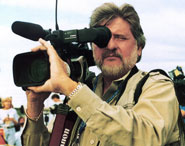 |
→ December 2007 Contents → Welcome
|
Welcome to the December issue of The Digital Journalist, the monthly online magazine for Visual Journalism.
This newsletter is being written from the Turks and Caicos Islands in the Caribbean. We know many of you are huddled by the fireplace right now, but for us, we are looking out at a beautiful azure ocean, nibbling conch fingers and sipping on a rum punch. We are just finishing our first wedding photography Platypus Workshop. After more than 23 workshops teaching photojournalists the art of film documentary, we are extending the program to a different breed of storytellers, those who want to offer High Definition video to their clients. The great thing about these workshops is that we get to go to places like the tropics in wintertime.
But, as they say in broadcasting, back to our regular program!
On the day he became the 38th president of the United States in August of 1974, Gerald R. Ford made two key appointments. The first was to appoint Henry Kissinger as Secretary of State, and the second was to commission Time photographer David Hume Kennerly as his personal photographer. For the next 30 months Kennerly was offered more access to a sitting president than any photojournalist before or since. Kennerly's terms of acceptance of the office were very simple: "I want total access at any time!" Ford responded, "Are you sure you don't want the use of Air Force One on weekends, too?"
This month, in our cover story, sponsored by The Center for American History at The University of Texas/Austin, Kennerly shows some of the key pictures he took behind the scenes of the Ford White House. His big coffee table book, "Extraordinary Circumstances: The Presidency of Gerald R. Ford," goes on sale in bookstores as this story appears.
On the Time team that covered the White House was another photographer, Diana Walker. We called her "Lady Di." Like Kennerly, she was a master of gaining access to the first families. Often using her Leicas, she was a discreet "shadow on the wall." This month as well, Diana's handsome new coffee table book, "The Bigger Picture," arrives on bookstore shelves. We are pleased to present excerpts from the book.
In mid-November, we published an editorial, between our normal cycles, urging our readers and photojournalists from around the world to put pressure on members of Congress and world leaders to press for the release of Bilal Hussein, an Iraqi AP staff photographer who was seized from his Ramadi home by U.S Marines in April of 2006, and who has been held in detention ever since, with no charges ever having been filed. We are pleased that thousands of photographers and others have signed a petition appealing for his release, and we are continuing the editorial this month, and urge you to sign the petition.
For December we have three Dispatches and an Update. Chris Hondros returns and goes to court with Iraqi prisoners, William B. Plowman looks at gang life in Gary, Indiana, and Veronique de Viguerie takes on the challenge of a story about the prostitution of young Iraqi women in Syria. Paul Taggart provides an "Update" of his dispatch last month from Pakistan.
E-Bits Editor Beverly Spicer writes her column this month about The Decisive Moment, and suggests that with new technology, that moment may be a blur.
In our "Camera Corner" column, Contributing Editor Chick Harrity reviews Nikon's new Pro Level D300 and discovers that it "seems to live up to all its hype and even exceeds it in a couple of cases, especially high ISO shooting."
Ron Steinman offers a provocative commentary, "Reading the War: Any War," about the mind-blowing glut of news coverage available in this digital age. Despite all of the information out there, however, reading about the war in Iraq, he says, "is an impossible and often frustrating experience."
Be sure to visit our loyal columnists, Bill Pierce, Mark Loundy, Terry Heaton and Chuck Westfall, again this month for more helpful and insightful articles.
For this year-end issue, Assignment Sheet offers two journals. One by Eileen Douglas is called "A Reporter's Life: 146 Million/Imagine That." Asking herself what she would do if she won $146 million in a lottery, Eileen talks about all of the wonderful travels she would embark upon and all the fascinating people she would meet. Then, she realizes that she spent her journalistic career doing precisely that and getting paid for it, too, Imagine that! Dick Kraus just couldn't resist going back in time once more, reminiscing about the colorful, bulky, non-automatic cameras of his youth and the colorful characters who used them. It's entitled, "Ahh, The Good Old Days."
Looking for a special, inspiring gift for someone this holiday season? Check out our "Books for the Holidays" recommendations for some of the best photography books published in 2007.
A note about the next few months:
In February, The Digital Journalist will be undertaking our first major redesign. Rest assured, you will find the same comfortable style that you have gotten used to, but we will be installing tabs on our home page and throughout the issue that will enable you to find features more easily, especially our archives. There will be a major upgrade in interactivity that will make it possible for you to comment on all our articles, plus a dramatic move to High Definition video that will fill your screen. In order to do this work, we will devote our January issue to "The Best of The Digital Journalist" from over the past 10 years, featuring some of our best features and columns. It will be a chance for you to revisit, or for those of you who have not been with us all these years, to see some of our award-winning work.
We hope you enjoy this issue. Happy holidays! Dirck Halstead
| ||||||
